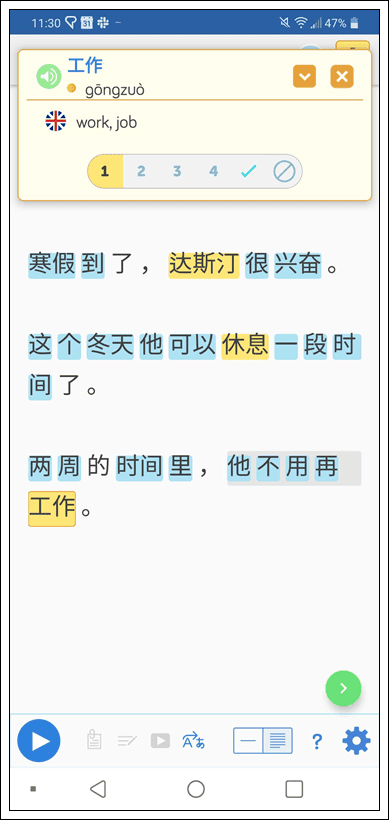Chinese Sentence Structure is Not as Hard as You May Think
When it comes to learning Chinese language from scratch, most Westerners get the impression that the only way to learn to speak, read, and write Chinese is by memorizing a bunch of random characters and emphasizing a bunch of tone marks while speaking. Well…they’re not wrong, but not 100% correct neither.
Even though learning Chinese can look scary, the nice thing about it is that the grammar rules are very straightforward compared to those used in English, French, and even Japanese. If you’re nervous about learning Chinese, then this post is for you.
I’ll show you the basics of Chinese sentence structure and why it’s not as hard as you may think by taking apart sentences piece by piece and explaining them.
To better understand what I mean, let’s take a look at these three simple concepts.
Sentence authority
By this, I mean as in two ways:
The subject, which is the most important part of the sentence, is always first, followed by the verb, which describes what the subject is doing, followed by the object, which is the thing associated with the object. In other words, SVO (subject, verb, object).
When it comes to dates and time, the “bigger times” are always placed at the very beginning, followed by the “second biggest”, and so on.
To better understand how these two concepts work, take a look at the following sentences below:
大卫玩电子游戏
dàweì wán diànziyóuxì
In this case, 大卫(dàweì, David) is the subject, 玩(wán, to play) is the verb that describes what David is doing, and 游戏 (diànziyóuxì, video games) is the object that David is playing with. Altogether, the sentence is translated (literally) as, “David plays video games.”
Now take a look at the next sentence:
大卫每天下课从下午六点半到午前三点钟玩游戏
dàweì meĭtiān xiàbān cóng xiàwŭ liùdiănbàn dào wŭqián sān diǎnzhōng wán diànziyóuxì
In this case, the “biggest time” is 每天(meĭtiān, everyday), followed by 下课(xiàbān, after school), followed by 从下午六点半到午前三点钟 (cóng xiàwŭ liùdiănbàn dào wŭqián sān diǎnzhōng, from 6:30 to 3:00). Altogether, the sentence reads, “David plays video games everyday after school from 6:30 pm to 3:00 am.”
Place markers That You Can “Fill In”
Chinese has its own versions of, “Who? What? Where? When? Why? How?”. Writing Chinese sentences is as easy as taking a simple sentence and “filling the words in.”
For instance, take a look at this “sentence structure” below:
对_____有好处
duì ___ yŏuhǎochù
The above example is used to describe something that is good/advantageous for the subject.
Previously, you learned that David has been playing games everyday after school from 6:30 pm to 3:00 am. He probably thinks that playing more video games is good for him.
If you want to describe David’s thoughts using the structure,对_____有好处, you would write:
他以为多玩电子游戏对他的身体有好处
tā yĭweí duō wandiànziyóuxì dui tāde shēntĭ yŏuhǎochù
In this case, 他(tā, he) is the subject, 以为(yĭweí, to think) is the verb, 多(duō) means “many” or “more”, 的(de) is a possessive particle, and 身体(shēntĭ) means “body.” Altogether, the sentence literally reads, “He thinks that playing more video games is good for his body. “
Easy, right?
But wait a minute. What if you want to say the opposite of 对_____有好处?
In that case, all you have to do is add the negation of that sentence next to the “positive word.” For this scenario, that would be 没(meí) as in 没有(meíyŏu, don’t have).
The formula would look like this:
对 ___ 没有好处
duì…meíyŏuhǎochù
This is used to describe something that is bad/disadvantageous for the subject.
Assuming that our friend, David, became wise at this point, the sentence would read:
他以为多玩电子游戏对他的身体没有好处
tā yĭweí duō wandiànziyóuxì dui tāde shēntĭ meíyŏuhǎochù
In other words, the sentence would read, “He thinks that playing more video games is bad for his body.”
The best part of Chinese sentence structure
Chinese Words have NO Tenses or Conjugations!
To illustrate what I mean, look at the following sentences below:
很多以前,大卫有一个女朋友
hěnduōyĭqián, dàweì yŏu yígè nǚpéngyŏu
In this sentence, 很多以前(hěnduōyĭqián) means “a long time ago”, 有(yŏu) means “to have” or in this case, “had,” 一个(yígè) means “one of something” or “a”, and 女朋友(nǚpéngyŏu) means “girlfriend.”
Altogether, the sentence reads as “A long time ago, David had a girlfriend.”
But notice that we left 有 the same. We didn’t change the character at all in order for the meaning to make sense.
Now let’s look at another sentence:
现在,他没有一个女朋友
xiànzài, tā meíyŏu yígè nǚpéngyŏu
In this sentence, 现在(xiànzài) means “right now.” As for 有, it is negated with the word, 没(meí). So 没有(meíyŏu) means “doesn’t have.”
Altogether, the sentence reads, “Right now, he doesn’t have a girlfriend.”
In this case, the word, 有, is always 有. In Chinese, “have, had, or has” usually remains the same (there are some exceptions to the rule but don’t worry so much for now).
Learn Chinese using content you love
It’s no secret that the more you read and listen, the better you’ll become at understanding Chinese. Even polyglot Steve Kaufmann agrees (he speaks 17 languages FYI).
However, reading Chinese can be difficult at first, especially since the characters are completely foreign to native English speakers.
But there’s a way to start reading right away…so you can learn faster.
Rather than looking up new words using a dictionary every minute and ruining your flow, check out LingQ. It’s the best way to learn Chinese online because it has a built in dictionary so you can easily look up words, save them, and review them in the ease of one platform.

Not only does LingQ make reading Chinese easier, it also is filled with thousands of hours of Chinese content. For example, if you’re a beginner, I recommend the Chinese mini-stories (pictured above).
These have been professionally transcribed so you can read and listen to the audio at the same time (and look up new words too). Not only that, but if you are feeling adventurous, you can import Chinese content from the web and study using videos from YouTube and much more. For example, you can import the transcripts from Chinese dramas (from the website Viki) and listen and read without any barriers. Best of all, you’ll learn at the same time.
Go check out LingQ today and make your studies a whole lot easier by discovering how to learn Chinese using content you love. Good luck.


